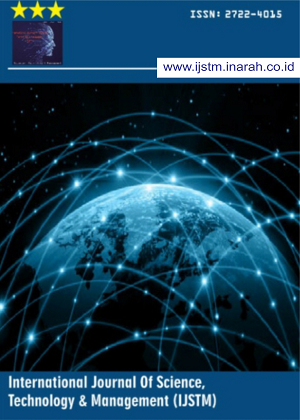Analysis of Public Satisfaction Levels Towards Hospital Services Using The K-Nearest Neighbors Method (Case Study: XYZ Regional Public Hospital)
Abstract
The level of public satisfaction with health services is an important indicator that reflects the quality of services provided by a hospital. XYZ Hospital, as one of the main health service providers, strives to continuously improve the quality of its services by understanding and evaluating the level of patient satisfaction. However, challenges arise when it comes to accurately identifying and predicting patient satisfaction, given the diverse characteristics of patients and the complexity of the services provided. Therefore, this study aims to analyze the level of public satisfaction with XYZ Hospital services using the K-Nearest Neighbors method. This study employs a quantitative approach by utilizing patient satisfaction data obtained through a survey. We then analyze the data using the K-Nearest Neighbors method, known for its effectiveness in classifying based on data proximity. We carry out the model performance evaluation process through an evaluation matrix that includes accuracy, precision, recall, and F1-score. The results of the study show that the K-Nearest Neighbors model is able to classify patient satisfaction with an accuracy value of 94%, precision of 97.67%, recall of 95.45%, and F1-Score of 96.55%. These results indicate that the K-Nearest Neighbors model is not only accurate in predicting patient satisfaction but also consistent in classifying patients who are satisfied and dissatisfied. The study's conclusion is that the K-nearest neighbors method is very effective in analyzing and predicting the level of patient satisfaction at XYZ Hospital. This study makes a significant contribution by utilizing the K-Nearest Neighbors model as a potent predictive tool for assessing patient satisfaction, a tool hospitals can employ to enhance service quality. We hope that further development will enable the larger-scale implementation of this model, thereby enhancing the quality of health services across various hospitals.
Downloads
References
Hardiansyah, Kualitas Pelayanan Publik (Konsep, Dimensi, Indikator dan Implementasinya). Yogyakarta: Gava Media, 2018.
M. F. T. Mutaqin, D. Darmawan, N. Handayani, and I. Masturoh, “Kualitas Pelayanan Publik Sektor Pendidikan: Analisis Survey Kepuasan Masyarakat di Kabupaten Pandeglang,” in Prosiding Seminar Nasional Pendidikan Non Formal, 2023, pp. 616–625.
P. P. Sary, Maria, and R. Armaini, “Faktor-Faktor yang Mempengaruhi Akuntabilitas Publik Badan Layanan Umum Daerah,” J. Darma Agung, vol. 31, no. 6, pp. 198–209, 2023, doi: 10.46930/ojsuda.v31i6.3616.
M. W. Kurniawan, S. Alifiyah, E. Setyowati, A. I. Jinan, A. W. Rahmadhani, and E. Nurhayati, “Tingkat Kepuasan Pengguna Terhadap Pelayanan Publik di Perpustakaan UPN Veteran Jawa Timur,” JIPP J. Ilmu Pendidik. dan Pembelajaran, vol. 06, no. 3, pp. 100–111, 2024.
I. Lastriyani, Lidiawati, R. S. Sauri, and I. Wasliman, “Kualitas Pelayanan Pendidikan di TK Aisyiyah Kota Sukabumi: Strategi Pendekatan Metode Service Quality,” Munaddhomah J. Manaj. Pendidik. Islam, vol. 4, no. 4, pp. 1047–1055, 2023, doi: 10.31538/munaddhomah.v4i4.876.
M. P. Permatasari et al., “Persepsi Kepuasan Layanan Transportasi Kereta Api PT. Kereta Api Indonesia (PT. KAI): Survey pada Mahasiswa yang Berkuliah di Surabaya,” Valuasi J. Ilm. Ilmu Manaj. dan Kewirausahaan, vol. 4, no. 2, pp. 561–575, 2024, doi: 10.46306/vls.v4i2.
N. Aprilia and D. I. Nur, “Kinerja Program Kalimasada Melalui Layanan Administrasi Kependudukan Di Kelurahan Gunung Anyar Tambak,” KARYA J. Pengabdi. Kpd. Masy., vol. 3, no. 3, pp. 218–229, 2023.
P. Ndikum, “Machine Learning Algorithms for Financial Asset Price Forecasting,” pp. 1–16, 2020, [Online]. Available: http://arxiv.org/abs/2004.01504
L. Ma and B. Sun, “Machine learning and AI in marketing – Connecting computing power to human insights,” Int. J. Res. Mark., vol. 37, no. 3, pp. 481–504, 2020, doi: https://doi.org/10.1016/j.ijresmar.2020.04.005.
V. M. R., R. Ashok, and L. Nitha, “Electric Vehicles Acceptance and Knowledge Identification in India using Naive Bayes and k-Nearest Neighbor Classifiers,” Int. J. Innov. Technol. Explor. Eng., vol. 9, no. 5, pp. 1630–1633, 2020, doi: 10.35940/ijitee.e3008.039520.
S. Diansyah, “Klasifikasi Tingkat Kepuasan Pengguna dengan Menggunakan Metode K-Nearest Neighbour (KNN),” J. Sistim Inf. dan Teknol., vol. 4, no. 1, pp. 7–12, 2022, doi: 10.37034/jsisfotek.v4i1.114.
H. A. Pratama, G. J. Yanris, and M. N. S. Hasibuan, “Implementation of Data Mining for Data Classification of Visitor Satisfaction Levels,” Sink. J. dan Penelit. Tek. Inform., vol. 8, no. 3, pp. 1832–1851, 2023, doi: 10.33395/sinkron.v8i3.12674.
R. Rismala, I. Ali, and A. Rizki Rinaldi, “Penerapan Metode K-Nearest Neighbor untuk Prediksi Penjualan Sepeda Motor Terlaris,” JATI (Jurnal Mhs. Tek. Inform., vol. 7, no. 1, pp. 585–590, 2023, doi: 10.36040/jati.v7i1.6419.
S. Rahayu, Y. MZ, J. E. Bororing, and R. Hadiyat, “Implementasi Metode K-Nearest Neighbor (K-NN) untuk Analisis Sentimen Kepuasan Pengguna Aplikasi Teknologi Finansial FLIP,” Edumatic J. Pendidik. Inform., vol. 6, no. 1, pp. 98–106, 2022, doi: 10.29408/edumatic.v6i1.5433.
F. Marisa et al., “Pengukuran Tingkat Kematangan Kopi Arabika Menggunakan Algoritma K-Nearest Neighbour,” JIMP J. Inform. Merdeka Pasuruan, vol. 6, no. 3, pp. 1–5, 2021, doi: 10.51213/jimp.v6i3.280.
F. Rozi, F. Sukmana, and M. N. Adani, “Pengelompokan Judul Buku dengan Menggunakan Algoritma K-Nearest Neighbor (K-NN) dan Term Frequency - Inverse Document Frequency (TF-IDF),” JIMP J. Inform. Merdeka Pasuruan, vol. 6, no. 3, pp. 1–5, 2022, doi: 10.51213/jimp.v6i3.346.
L. T. Amelia, H. L. Sari, and R. Zulfiandry, “Penerapan Algoritma K-Nearest Neighbor dalam Mengukur Tingkat Kepuasan Masyarakat pada Pelayanan Umum Kantor Kelurahan Belakang Pondok Bengkulu,” Djtechno J. Inf. Technol. Res., vol. 3, no. 2, pp. 208–216, 2022, doi: 10.46576/djtechno.v3i2.2733.
M. Fansyuri, “Analisa Algoritma Klasifikasi K-Nearest Neighbor dalam Menentukan Nilai Akurasi Terhadap Kepuasan Pelanggan (Study Kasus PT. Trigatra komunikatama),” Humanika J. Ilmu Sos. Pendidikan, dan Hum., vol. 3, no. 1, pp. 29–33, 2020.
D. J. Triani, M. H. Dar, and G. J. Yanris, “Analysis of Public Purchase Interest in Yamaha Motorcycles Using the K-Nearest Neighbor Method,” Sink. J. dan Penelit. Tek. Inform., vol. 7, no. 3, pp. 1238–1254, 2023, doi: 10.33395/sinkron.v8i3.12433.
Copyright (c) 2025 International Journal of Science, Technology & Management

This work is licensed under a Creative Commons Attribution-ShareAlike 4.0 International License.
































